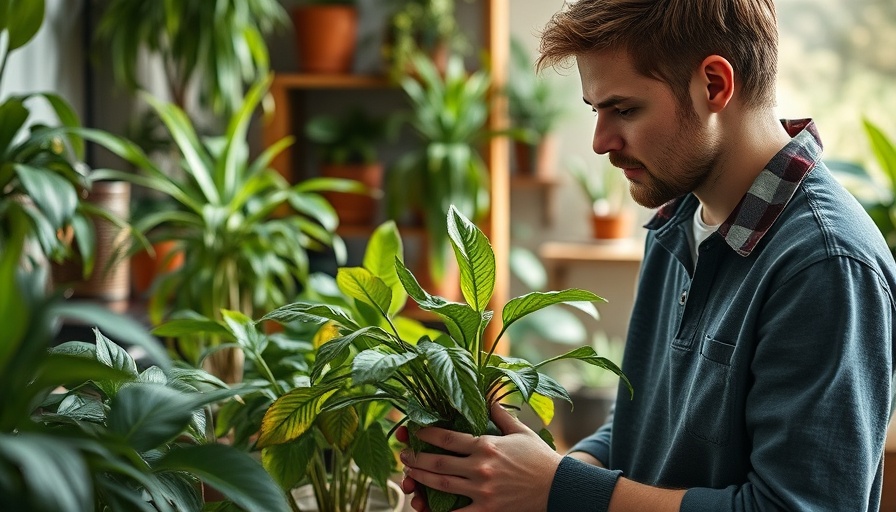
Uncovering the Secrets Behind Dead Houseplants
Houseplants bring life, greenery, and fresh air into our homes. They connect us with nature, can elevate our mood, and even beautify our living spaces. Yet, what happens when this vibrant life wilts? Many homeowners find themselves puzzled over why their once-thriving greens suddenly turn brown or droop lifelessly. Before you bid farewell to your leafy friend, let’s dig into some common causes for houseplant demise and what you can do to save your botanical companions.
Watering: The Double-Edged Sword
Improper watering is among the most prevalent reasons houseplants reach their end. Whether it’s overwatering or underwatering, both can lead to fatal consequences. A waterlogged pot suffocates roots, causing yellowing and leaf drop. Conversely, prolonged dryness can render the plant thirsty and brittle, leading to a slow death.
Consider this—houseplants aren’t all created equal when it comes to hydration. Varieties like the snake plant can thrive on infrequent watering, while others such as the peace lily have distinct moisture needs. A vital step is assessing your plant’s watering history: Is the soil often too wet or dry? Look to the roots: mushy and black roots indicate overwatering, while shrunken roots suggest a thirsty plant.
Environmental Factors: Light and Soil
The environment you create for your plants dramatically impacts their health. Insufficient light may lead to leggy growth as the plant stretches toward the sun, while too much direct sunlight can cause leaf burn. Understanding the light preferences of each plant is crucial; tropical plants may require bright indirect light, while succulents thrive in direct sunlight.
Soil quality also matters. Using the wrong type of soil can keep your plants from thriving, making it essential to select soil that matches your plant’s needs. For instance, cacti and succulents do best in well-draining soil, while ferns enjoy moisture-retaining varieties. Keep an eye on your pot size as well—an oversized pot can lead to waterlogged roots, while undersized pots restrict growth and hydration.
Diagnosing Pests and Diseases
If you’ve assessed your watering and environmental conditions but your plant is still struggling, it may be time to investigate further. Common pests like spider mites, mealybugs, and aphids can sap the vigor from your plants. Identifying these pests is the first step toward treatment. Look for signs such as webbing or white masses on leaves, and consider using neem oil as a natural pesticide.
Diseases can also strike houseplants, often resulting in yellowing leaves or sudden wilting. The key is to remove infected foliage quickly to prevent the spread of the disease. Increasing air circulation around your beleaguered plants can also fend off fungal infections, often exacerbated by humidity.
Future Growth: Understanding Plant Needs
To ensure your houseplants flourish, consider this: proper care isn’t a one-size-fits-all approach. Diana David, an expert horticulturist, emphasizes the importance of adapting care to mimic each plant's natural habitat. Researching the specific needs of your houseplants—such as their light, watering, and soil preferences—can set you up for success.
Furthermore, seasonal changes can alter your plant's needs. During warmer months, houseplants may require more frequent watering and humidity, while winter may necessitate reduced water and more indirect light sources. Regularly revisit your care routine to adapt to these changes.
Take Action: Reviving Your Houseplant
If you’re staring at a sad, droopy plant and wondering if it’s too late—don’t throw in the towel just yet! By following the proper checks and adjustments, you can often revive even the most distressed houseplants. Start with the finger test: stick your finger into the soil, measuring moisture level. Assess light exposure, and consider repotting with suitable soil if it appears root-bound.
Sometimes, simply moving your houseplant to a different location with more appropriate light can rejuvenate them. You might be surprised by how resilient your plant can be with the right care.
Conclusion: The Joy of Nurturing Houseplants
Embracing houseplant care creates a rewarding bond between you and your greenery. Understanding the reasons behind their struggles not only helps in rectifying issues but fosters a sense of accomplishment as you witness their revival. If you want an enriching adventure in plant care rather than despair, ensure you engage with your plants regularly. Discover their preferences, nurture that relationship, and watch your indoor jungle thrive!
Before you part with a struggling houseplant, take the time to diagnose the issues and implement effective solutions. Your resilient green companions may still have a fighting chance!
 Add Row
Add Row  Add
Add 




Write A Comment